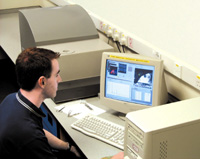SIMS Instrument
Our SIMS Capabilities
In the laboratory's instrument SIMS can provide chemical images, elemental depth profiling down to 100nm, molecular cluster information and much more. The specification of the instrument and its capabilities are listed below:
 Main features of the laboratory's SIMS capability
Main features of the laboratory's SIMS capability
- Analysis of elements and isotopes atomic numbers Z=2 to Z=103 as well as molecules and fragments from 2-300amu).
- 300amu quadrupole mass spectrometer for atomic and molecular ion detection in both positive and negative ion modes.
- Focused gallium primary ion source with an ultimate instrument lateral resolution of 5μm.
- The analytical field of view can be zoomed in from 4.5x4.5mm by 20x to 225x225μm.
- Secondary electron detector for SEM of conductors and semiconductors to allow rapid determination of the area of interest for SIMS.
- Electron source for charge compensation of insulators.
- Instrument capable of large area, small area and point spectroscopy. These areas can be chosen from the SEM image, any chemical image or from an optical image before sample loading.
- Rapid molecular and atomic ion chemical imaging (typically 30s / map).
- Extremely fast sample entry system into a high vacuum (HV) chamber. It has a high sample throughput compared to other types of SIMS instruments, ideal for quality control roles or getting good sampling statistics.
- Basic chemical depth profiling is possible down to depth of ~100nm.
- The instrument takes solid samples up to 10mm diameter (12.5mm possible in exceptional cases) and 4mm thick. Larger samples can be cut carefully down to size in the laboratory.
- Optical camera on entry lock to generate photos of samples and permit identification of areas of interest for analysis when SED imaging cannot be used.
Our site expert on SIMS is Dr Stephen Jenkins.
Application Notes

